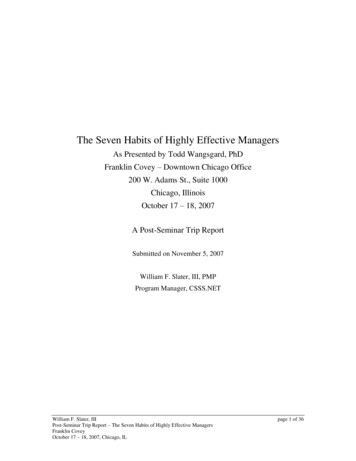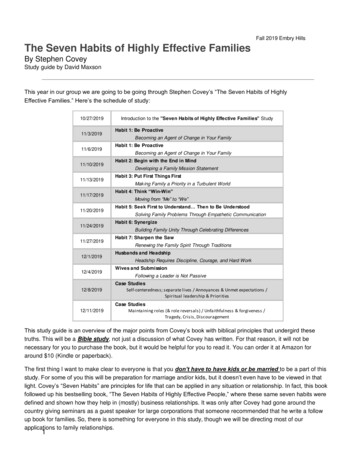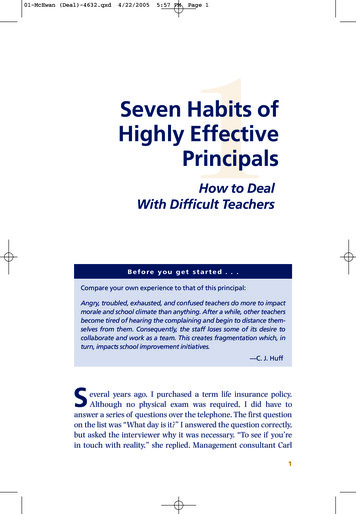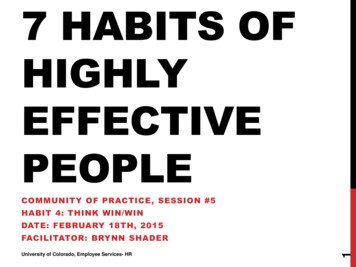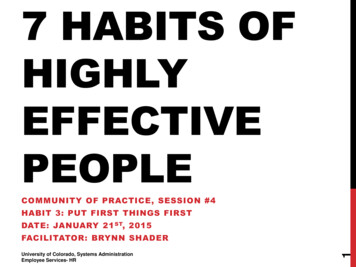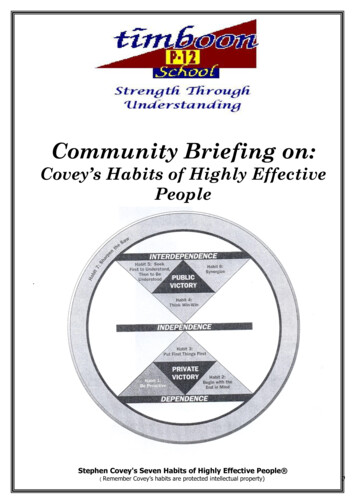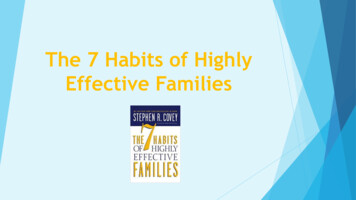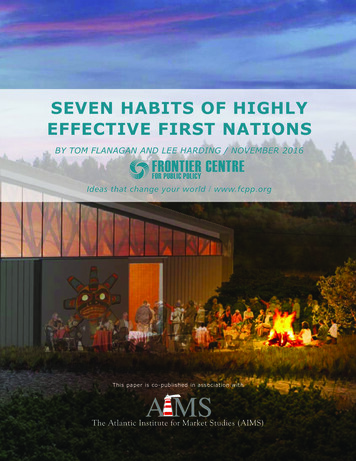
Transcription
FRONTIER CENTRE FOR PUBLIC POLICYSEVEN HABITS OF HIGHLYEFFECTIVE FIRST NATIONSBY TOM FLANAGAN AND LEE HARDING / NOVEMBER 2016FRONTIERCENTREFOR PUBLIC POLICYIdeas that change your world / www.fcpp.orgThis paper is co-published in association withThe Atlantic Institute for Market Studies (AIMS)1
FRONTIER CENTRE FOR PUBLIC POLICYTOM FLANAGAN, Chair, Aboriginal FuturesTom Flanagan is the Chair of the Aboriginal Futures program. He is ProfessorEmeritus of Political Science at University of Calgary, where he taught for morethan 45 years, serving as Department Head, Advisor to the President and aDistinguished Fellow at the School of Public Policy. Dr. Flanagan has been Chief ofStaff to Prime Minister Stephen Harper and a strategy and campaign advisor tonumerous federal and provincial political campaigns. He is a Fellow of the RoyalSociety of Canada.Dr. Flanagan is a monthly columnist for the Globe & Mail and frequent contributorto national and international press such as MacLeans and Time magazines. He isthe author of several award-winning books on aboriginal topics, including MetisLands in Manitoba, First Nations? Second Thoughts and Beyond the Indian Act.LEE HARDING, InternLee Harding is a Master’s Candidate at the School of Public Policy at the Universityof Calgary. He also has a Bachelor of Arts in Journalism from the University ofRegina and a Bachelor of Arts in Theology from Briercrest College and Seminary.After working as a television reporter for CBC, CTV, and Global in Regina,Saskatchewan, he joined the Canadian Taxpayers Federation in 2007 to becomeits Saskatchewan Director. For the past five years he has worked as a field agentto fundraise for the CTF. He is a loving father of two daughters. In his spare timehe enjoys distance running and cheering for the Saskatchewan Roughriders.FRONTIERCENTREFOR PUBLIC POLICY203-2727 Portage Avenue, Winnipeg, Manitoba Canada R3J 0R2Tel: 204-957-1567Email: manitoba@fcpp.orgThe Frontier Centre for Public Policy is an independent, non-profit organization that undertakes research and educationin support of economic growth and social outcomes that will enhance the quality of life in our communities. Through avariety of publications and public forums, the Centre explores policy innovations required to make the prairies regiona winner in the open economy. It also provides new insights into solving important issues facing our cities, towns andprovinces. These include improving the performance of public expenditures in important areas such as local government,education, health and social policy. The author of this study has worked independently and the opinions expressed aretherefore their own, and do not necessarily reflect the opinions of the board of the Frontier Centre for Public Policy.Copyright MMXVI by the Frontier Centre for Public Policy.Date of First Issue: November 2016.Reproduced here with permission of the author. Any errors or omissions and the accuracyand completeness of this paper remain the responsibility of the author.ISSN 1491-78Ideas that change your worldwww.fcpp.org2
FRONTIER CENTRE FOR PUBLIC POLICYTABLE OF CONTENTSExecutive Summary.4Introduction.5Places and People.7The Wealth of First Nations.9Governance.11Seven Habits of Highly Effective First Nations. 13Appendix. 15Bibliography. 16Endnotes. 183
FRONTIER CENTRE FOR PUBLIC POLICYEXECUTIVE SUMMARYThis paper examines 21 First Nations in Canada who scored highly on the 2011Community Well-being Index (CWB), which is computed by researchers at theDepartment of Indian and Northern Affairs (INAC) after each census. The CWB Indexincludes Statistics Canada data related to incomes, labour market participation,educational achievement and housing quality. 11 of these 21 high-achieving FirstNations are located in British Columbia, well above the province’s share of First Nationsnationally (32 percent). The others are scattered throughout Canada, showing thathigh achievement for First Nations is not limited to any single region.The authors discuss commonalities to many of the 21 successful First Nations, includinggeographical proximity to non-Aboriginal municipalities, willingness to capitalizeeconomically on whatever local advantages exist, a smaller average population thanother First Nations, their use of land as an economic asset, fiscal responsibility, goodgovernance, trust in talented leaders and independence from INAC. They concludethe following as the seven habits of highly-effective First Nations:1.2.3.4.5.6.7.Recognizing the economic potential of land.Taking advantage of local opportunities.Remaining flexible through diverse investments.Respecting and supporting effective leaders.Running a businesslike, economic government.Taking control of decision-making from INAC.Willingness to cooperate with others, including non-First Nations communities.The authors acknowledge that “many First Nations, particularly those in remotenorthern and rural locations, may have none of these advantages and thus mayhave to look for other pathways to success. But even in such situations, there can bepromising opportunities.” Where implementable, the “seven habits of highly-effectiveFirst Nations” constitute a template for progress.4
FRONTIER CENTRE FOR PUBLIC POLICYINTRODUCTIONafter every quinquennial census. It aggregates datacollected by Statistics Canada about incomes, labourmarket participation, educational achievement, andhousing quality. Each of these four dimensions isnormalized and weighted equally to produce anoverall score, the CWB, ranging in principle from 0to 100.4Much has been written about the difficulties facedby First Nations in Canada, but less about thoseFirst Nations that are succeeding in raising theirstandard of living to general Canadian norms.1Earlier research has highlighted the importance ofstable governance adhering to the rule of law andrespect for property rights.2 Here we want to gofarther by putting the spotlight on a sample of FirstNations that are demonstrably doing very well forthemselves. This research strategy assumes that thestudy of success will generate lessons that can beapplied by other First Nations as they work towardsimproving their own standard of living. Popularculture has absorbed the phrase “the seven habitsof highly effective people” from Stephen R. Covey’sbest-selling book of the same title.3 In this paper, weare looking for “seven habits of highly effective FirstNations” (we drop the article “the” because we donot want to imply that there are only seven habitscharacterizing successful First Nations).Note that the CWB is a community measure; it doesnot include information on members of a First Nationwho live off reserve. Other research strategies arerequired to study the individual well-being of thosepeople.5 Also, the CWB measures certain thingsbut not others; it does not include data on culturalintegrity, community solidarity, language retention,health and longevity, and many other things thatFirst Nations people may value highly. But even ifthe CWB does not measure everything, what it doesmeasure is universally admitted to be important.First Nations leaders unanimously speak about theimportance of higher incomes, more jobs, bettereducation, and better housing. Success in theseareas is not incompatible with retention of culturalvalues and may even be helpful; for example,a more prosperous community will have moreto spend, if it chooses to do so, on linguistic andcultural preservation.The original plan for this research was to look at the“Top 20” First Nations as measured by their score onthe 2011 Community Well-being Index (CWB). TheCWB is computed by researchers in the Departmentof Indigenous and Northern Affairs Canada (INAC)Chart 1 shows CWB scores for First Nations and nonaboriginal communities over the years 1981-2011.6CHART 1AverageCWB Scores8580(1981-2000)7775Average CWB 1991199652011
FRONTIER CENTRE FOR PUBLIC POLICYAverage scores have been improving for both FirstNation and other communities during this 30-yearperiod, but the 20-point gap between the two hasremained more or less constant, after appearing toclose a little towards the end of the 20th century.First Nations on average lag behind other Canadiancommunities, but there is also much variation amongFirst Nations themselves. For 2011, their CWB scoresranged between 39 and 78 (after eliminating the2.5% outliers at either end of the distribution). Atthe upper end, the CWB of First Nations is very closeto the Canadian average.7The research is based on publicly available informationfound in websites and media reports about theTop 21, supplemented by statistical informationas mentioned above. It fills a gap in the literaturebetween individual case studies, which rely on sitevisits and interviews, and statistical studies of theentire set of First Nations. It is meant to be a groupportrait of outstanding success.A somewhat similar piece of research was publishedby INAC in 2013.9 That study was based on a sampleof 25 First Nations with above-average CWB scores,five of which are also included in this report. However,the researchers did not employ statistical methods.They interviewed chiefs and other community leadersto collect their opinions about economic developmentand distilled their impressions into generalizations.As with this study, they discovered the importanceof usable property rights and stable, businesslikegovernance. They also emphasized ways in whichthe Indian Act and INAC regulations often impedeFirst Nations from making progress in the world ofbusiness. Though the present study takes a morestatistical approach towards establishing empiricalgeneralizations, its findings are consistent with thoseof the INAC project.CWB scores for the First Nations examined in thisstudy range from 73 to 83 (high-end outliers wereincluded). The sample is comprised of 21 rather than20 cases because seven First Nations were tied at73 and we didn’t want to arbitrarily exclude any ofthem. The 21 cases are listed in the Appendix. Itshould also be noted that the sample was drawnfrom a database compiled for earlier research thatincludes a large number of variables relevant togovernmental and economic performance, variablesthat are central to this analysis.8 Some high-scoringFirst Nations are not in that database because wecould not obtain information on all relevant variables.Thus this group may not be literally the “Top 21,”but it is certainly a set of 21 First Nations that havebeen successful in raising their standard of living andwhose performance is worthy of close study.6
FRONTIER CENTRE FOR PUBLIC POLICYPLACES AND PEOPLEfishing stations led many reserves to be locatednear cities or towns, because the new settlers alsowanted to exploit the fisheries and take advantageof transportation by water in such a mountainousprovince.Eleven of the 21 First Nations in the sample are in theprovince of British Columbia, whereas the remainingten are scattered across six other provinces andthe Northwest Territories. Why the concentrationin British Columbia? For one thing, that provincehas a disproportionate number of First Nations —198 out of 617, or 32% of the Canadian total. Butthe discrepancy in our sample (11/21 52%) iseven greater than that. One possible explanation isthat no treaties were negotiated in most of BritishColumbia. A study by INAC researchers found thatFirst Nations in British Columbia and elsewhere whonever signed “Historic Treaties” (i.e., 19th centuryland-surrender agreements) tend to have higherCWB scores and higher rates of improvement thanthose who did sign such treaties.10 The causalitybehind this finding is unclear but may havesomething to do with the way in which the 19thcentury treaties promoted a culture of dependency.That would be deeply ironic: the absence of treatiesin British Columbia and the Atlantic provinces hasbeen one of the main grievances of the modernaboriginal rights movement, and yet maybe FirstNations were better off without them.Every one of the 11 BC First Nations in the Top 21 islocated either within or not far from a municipality.The Musqueam Indian Band is within the city ofVancouver, and the Tsawout First Nation is only15 minutes north of Victoria. Other members ofthe group on Vancouver Island are located nearthe towns of Sooke and Campbell River. On themainland but not far from the coast, member FirstNations will be found near the cities of Missionand Chilliwack; and in the interior, near Osoyoos,Invermere, and Barriere. None of the 11 BC FirstNations in the sample is in a situation even remotelycomparable to the often impoverished First Nationsin the northern parts of Saskatchewan, Manitoba,and Ontario, hundreds of kilometres from anyurban settlement and reachable only by airplane orwinter road.Location near a town or city offers many advantagesfor economic progress, including the following: Jobs;Another explanation may lie in the realm of cultureand geography, i.e., the characteristics of BritishColumbia’s First Nations and the way that landreserves were allocated by the colonial government.11Most BC First Nations relied on fisheries, especiallysalmon, either on the Pacific Coast or along the shoresof inland lakes and rivers. The colonial governmentawarded them a large number of small reserveslocated near fishing stations rather than a smallernumber of big reserves. As a result, aboriginalpeoples were broken up into numerous bands foradministrative purposes, and these bands becametoday’s First Nations. For example, the Shuswap(Secwepemc) people are one cultural and linguisticnation, yet they are divided today into 17 bandsor First Nations scattered around the mountains ofsoutheastern BC. That, in a nutshell, is why BC has adisproportionate number of Canada’s First Nations.Moreover, the creation of Indian reserves around Consumer goods whose price is lower becauseof retail competition; Markets for the fish, game, and agriculturalproduce of the reserve; A much wider range of educational opportunitiesthan the small schools on Indian reserves canoffer; Availability of professionals, such as lawyers andaccountants, needed by entrepreneurial FirstNations; Demand for land that can be used for industrial,commercial, residential, and recreationalpurposes.Thus it is not surprising that BC First Nations locatednear towns or cities are the largest group in thissample of successful First Nations.7
FRONTIER CENTRE FOR PUBLIC POLICYThe location variable is more complicated outsideof British Columbia. The Membertou First Nationoccupies an urban reserve in Sydney, Nova Scotia;and the Madawaska Maliseet First Nation is situatedclose to Edmundston, New Brunswick. The othereight First Nations in our group are in a variety oflocations, sometimes quite far from any town orcity other than their own community. But thereare some recurrent themes. Several are in primerecreational country, such as the Buffalo Point FirstNation on the Lake of the Woods, and the WhitefishRiver First Nation on Georgian Bay. The Chippewasof Rama First Nation are on the shore of LakeCouchiching, near Orillia, and even more importantlyare licensed to operate a major casino. Others aretaking advantage of local resource developmentplays, such as the Fort MacKay First Nation on theAthabasca River in the Alberta oil sands, and theMatatchewan First Nation, located in the mining andforestry country north of Temiskaming, Ontario.spread among a larger population. Larger populationwould be an asset if a First Nation were pursuing anAsian-style development strategy based on cheaplabour and manufacturing, but that is not happeningin Canada. So, for the foreseeable future, smallerthan average First Nations, assuming they havelocational advantages, may improve their CWBscores more rapidly than larger ones would be ableto do. This finding, however, should be consideredquite tentative. The Top 21 sample does not includelarge and prosperous Iroquois First Nations inOntario and Quebec that do not allow StatisticsCanada to conduct a census enumeration.Because British Columbia First Nations are sonumerous in this group, Coast and Interior Salishlinguistic-cultural backgrounds are especially wellrepresented. But the group of 21 also includesDene, Cree, Ojibwa, and Algonquian (Mi’kmakand Maliseet) First Nations. Such ethno-culturaldispersion suggests that success as defined here isnot narrowly tied to any particular tribal heritageand should be attainable by many First Nations ifother conditions are favourable.Pulling these situational features together resultsin the generalization that successful First Nationscapitalize on whatever locational advantagesthey have, typically including one or more of thefollowing: Multiple business advantages offered by locationwithin or near a town or city; Recreational country, especially on waterfront; Nearby resource development, which caninclude oil and gas, hard-rock mining, forestry,and specialized agriculture, such as grapegrowing and wine-making.There is no single path to progress except to makeuse of whatever advantages are available.It is perhaps noteworthy that these 21 First Nationsare considerably smaller than average. Their meanmembership total is 910, versus 1556 for the entiredatabase. Other things being equal, it may beeasier to raise the standard of living of a smallergroup using the territorially based developmentstrategies pursued by these First Nations. Land andlocation are their major resources, so the benefitsof exploiting these resources would be more thinly8
FRONTIER CENTRE FOR PUBLIC POLICYTHE WEALTH OF FIRST NATIONSrestaurants, golf courses, marinas, and campgrounds.There are four major casinos plus smaller establishmentssuch as bingos. Some deliberately invite tourism by holdingThe economic development of the Top 21 has broughtcultural events and promoting native arts and crafts. Allwith it not only more revenue for those First Nations butthese activities involve using land as an economic resourcegreater independence. They have financial assets (mostly(sometimes leased to outside operators), but they alsoin INAC trust accounts but some in conventional financialinvolve members of the First Nation as workers andinstruments): an average of 8.49 million for the Top 21entrepreneurs. When band members are earning income,in 2013-14, versus a mean of 4.2 millionnot just receiving rents or government transfers, there are12for the entirepositive effects on education and housing.database. They are generating more own-source revenuefrom property taxes and business operations: an averageSome First Nations also generate income from theirof 39% of their annual budgets, versus 28% for all thereserve lands or traditionally used lands and waters byFirst Nations in the database (Note: the percentage ofexploiting natural resources. The Lidlii Kue, Matatchewan,own-source revenue would never reach 100% becauseand Simpcw First Nations are involved in hard-rock miningFirst Nations, like other municipalities in Canada, receiveby furnishing workers as well as investing in projects.various transfers from senior governments.)The Fort MacKay First Nation is known for participating inNationthe oil sands through local service and labour contractinggovernments into serious economic players, with moneyagreements. Wee Wai Kai pursues fish farming in Pacificin the bank, reliable credit histories, and substantial cashwaters, while the Membertou First Nation has a commercialflows coming primarily from government but bolstered byfishing enterprise in the Atlantic.14 The Osoyoos Indiantheir own-source revenues. The benefits also show up inBand is famous for its production of grapes and wine — aCWB scores, which measure not the wealth of the Firstspecific form of on government but the standard of living of the wholeIt is noteworthy that Fort MacKay is the only one of thecommunity, including personal income, labour forceTop 21 to base its business strategy on the petroleumparticipation, education, and housing.industry. Dozens of First Nations in western Canada haveWhat exactly are they doing to earn this additionalbeen earning royalties from oil and gas for decades.revenue and enhance their standard of living? AlthoughSometimes the amounts have been very large and havethere is no single business strategy, certain themesled to major business developments, such as the creationfrequently appear.of Peace Hills Trust by the Samson Cree Nation. Yet oil-richbands have not generally achieved high scores on the CWBFirst and foremost is the use of land as an economicindex. This phenomenon is worthy of further investigation,asset. At least half a dozen of these First Nations havebut Indian Oil and Gas Canada, which manages all oilmarketed residential developments, which can be eitherand gas resources on behalf of First Nations, puts littleseasonal recreational dwellings or permanent homes.information in the public domain.15 One hypothesisThis brings in money up front in the form of pre-paidworth pursuing is that the paternalistic approach takenleases as well as an annual income flow through propertyby Canada in this area (management of resources by ataxes and service fees. Beyond this, almost all of the Topgovernment agency) has not stimulated entrepreneurship21 are in the commercial real estate market, leasing landand workforce participation as much as the bottom-up,for small retail stores as well as large shopping centres.self-determination strategies pursued by the Top 21.16Perhaps the most unusual leasing project is the contractby the Osoyoos Indian Band to host a British ColumbiaSome of the Top 21 have approached natural-resourceprovincial prison.exploitation differently, taking advantage of current trends13in environmentalism. The Tsou’ke, Alderville, WhitefishA great deal of the economic activity falls into theRiver, and Simpcw First Nations are developing variousinterrelated categories of hospitality and recreation. Theseforms of green energy — wind, solar, and run-of-riverFirst Nations have numerous hotels, conference centres,hydro — depending on circumstances. The Leq’a:mel First9
FRONTIER CENTRE FOR PUBLIC POLICYNation is making a business of environmental monitoring.In short, these First Nations have developedFinally, many of these First Nations have set up their ownbusiness strategies to take advantage of theirprograms of job training, sometimes in connection withlands and location. Lacking large populations fortheir own enterprises, such as construction companies,manufacturing, or highly skilled work forces forsometimes as part of their labour-force contracting withtechnology, or large pools of capital for investment,outside business partners.they are capitalizing on the one factor of productionin which they are relatively strong — land, withattendant location and resources. Control of landcan lead to real estate leasing, then to hostinghospitality and recreational industries, and in somecases to development of natural resources. Also,these First Nations are trying to leverage their landsand resources in order to foster entrepreneurshipand job creation, rather than simply collectingrents.10
FRONTIER CENTRE FOR PUBLIC POLICYGOVERNANCEanother member of the same First Nation. Only fourof these First Nations have no CPs at all. The overallprevalence of CPs in this group is about two and a halftimes as high as for First Nations as a whole. Earlierwork shows that the prevalence of CPs on a reserveis strongly correlated with higher housing quality, asCPs allow some of the advantages of home ownership,although not including increase of equity because ofthe restricted re-sale market.21Eleven of the top 21 First Nations have an Indian Actform of local government, with elections for chief andcouncil every two years. The other ten have customarygovernment, in which the chief and council are chosenin various ways, including inheritance, elite co-optation,and various forms of election. In previous quantitativestudies with larger samples, Flanagan has tested theIndian Act/custom government difference as a variableand has never found it to achieve statistical significanceas an explanatory factor. It seems the most importantthing is what government does, not how it is chosen.This is consistent with the finding of the HarvardProject on American Indian Economic Developmentthat native government works best when it is “culturallyappropriate.”17Another dimension of the AGI is fiscal responsibility,and here our group of 21 also performs very well.22Only one, Buffalo Point First Nation, was in any level ofdefault management at the time of data collection. Inother words, these First Nations balance their budgetsand pay their bills on time. Even though there is nothingintrinsically wrong with borrowing money for capitalprojects and business investment, the limited fiscal baseof First Nations governments gives them good reasonto be cautious. Only three of these 21 (Membertou,Cape Mudge, and Osoyoos) have entered the borrowingfacility of the First Nations Finance Authority.23On the Aboriginal Governance Index (AGI) developedby Flanagan and Johnson, the Top 21 have an averagescore of 33.8, versus 25.5 for the entire database. Thiswas to be expected because the AGI was calibratedagainst CWB scores to test its validity. It was, therefore,a foregone conclusion that the Top 21 would haveabove-average scores on the AGI.The results become more meaningful when we drill downmore deeply into the data. One important dimension ofthe AGI is recognition of the economic value of land andrespect for property rights, to the extent that is possiblewithin the limited confines of the Indian Act. Of these21 First Nations, 15 have adopted some form of localtaxation, mostly property tax applied to leaseholds.18Such taxation can be an important generator of ownsource revenue for bands. Nine of these First Nationshave entered the First Nations Land ManagementAgreement, and seven others are working towards thatgoal.19 Being accepted into the Agreement allows a FirstNation to escape the strictures of the Indian Act andmanage its reserve lands without constant recourse toINAC for approval of transactions.Interestingly, the Top 21 economize on paying theirleaders, even though these leaders seem to be runningsuccessful governments. Returns for 2013-14 filed underthe First Nations Financial Transparency Act show thatthe Top 21 spent an average of 4309 per on-reserveresident in compensating chief and council, comparedto an average figure of 5371 for the entire database.This is consistent with earlier research showing that,after controlling for the effect of several other factors,level of compensation is negatively correlated with CWBscores.24 It is even more impressive considering thatthese First Nations are smaller than average and thus donot have the advantage of economies of scale. Overall,successful First Nations tend to spend more money onbusiness investments and services for their membersand less on making their leaders wealthy. Some chiefsand councillors who exercise executive functions areindeed highly compensated, but overall payment topolitical leaders is kept within bounds.These First Nations also make greater use of Certificatesof Possessions (CPs).20 The CP is the highest form ofprivate property available on Indian reserves underthe Indian Act. It is similar to ownership in fee simpleexcept that the holder can transfer the CP only toAn important generalization is that the Top 21 havetaken steps to escape the control of the Department ofIndigenous and Northern Affairs. Approving certificatesof possession gives individual band members controlover parcels of land. Participating in a land management11
FRONTIER CENTRE FOR PUBLIC POLICYagreement gives a First Nation more discretion in the useof its reserve lands. Instituting local taxation generatesrevenue in addition to federal transfers. Running abalanced budget gives the Department no reasonto appoint outside managers. These First Nations areexercising sovereignty and self-determination in a dayto-day practical sense by managing their own businessaffairs responsibly and profitably.hundred people is lucky to find even one talented, harddriving leader in its midst.Of course, governance is not perfect, even amongthis high-performing group. Successful First Nationshave not created utopia; they live in the real world ofaboriginal politics, in which many structural featurespromote factionalism, corruption, nepotism, and conflictof interest.27 Thus leaders sometimes get into dubioussituations. For example, Buffalo Point hereditary chiefJohn Thunder has been embroiled in multiple conflictssince 2013 — with a dissident faction in the band thatwants to oust him; with cottage owners complainingabout the level of property taxes on their leaseholds;and in a personal feud with Senator Don Plett, whichled to the chief’s
culture has absorbed the phrase “the seven habits of highly effective people” from Stephen R. Covey’s best-selling book of the same title.3 In this paper, we are looking for “seven habits of highly effective First Nations” (we drop the article “the” because we do not want t


